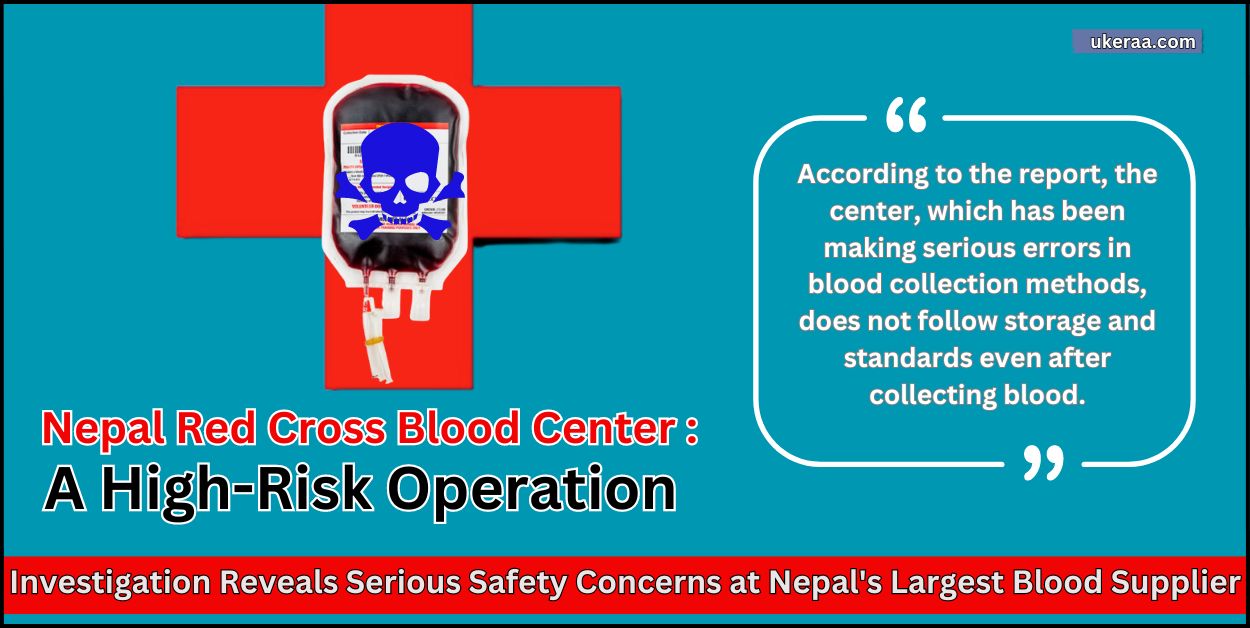Nepal's Blood Supply in Jeopardy: Red Cross Center Falls Short on Safety Standards

Kathmandu: As the risk of floods and landslides increases, so does the potential number of injured people, which in turn increases the demand for blood. However, it has been revealed that using blood from the Central Blood Transfusion Service under the Nepal Red Cross, which supplies the most blood in Nepal, poses a high health risk during this critical time.
According to claims made on its official website, the Nepal Red Cross Society provides 4 million units of blood annually. However, a study report has revealed that using blood from its center is a high risk due to serious errors in following protocols and standards.
A committee formed by the Social Welfare Council to investigate irregularities in the Red Cross also conducted a technical study on the quality of the Blood Transfusion Center under the Red Cross. The technical report provided by two experts shows that using blood from the center is highly risky in the current situation.
On April 29, the Social Welfare Council had formed a 5-member committee led by Sanjay Kumar Sah to investigate the malpractices in the Red Cross. The council had also formed a technical committee to support the same committee.
The technical investigation team, led by Dr. Bipin Nepal and Dr. Rekha Manandhar, which included representatives from the National Public Health Laboratory, found that most standards were at high risk when investigating the technical aspects of the Central Blood Transfusion Center.
Based on the reports from both individuals, the study committee recommended that "as the reports studying the Central Blood Transfusion Center show serious problems regarding quality and have suggested and recommended immediate solutions, immediate appropriate action is necessary from the Social Welfare Council, Ministry of Health and Population, Ministry of Women, Children and Senior Citizens, and Ministry of Home Affairs."
The report states that "as blood collection and distribution is an extremely sensitive issue for human health, it seems appropriate to keep the problems pointed out by technical reports on quality confidential rather than immediately making them public, and to focus on implementation."
The committee's report concluded that there is a high risk based on the selection of blood donors, blood collection, processing, storage, and the condition of equipment used.
After seeing the serious issues mentioned in the report about the quality of the center's blood, we sent the technical report to a knowledgeable doctor.
His reaction was, "If the center's condition is as described in the report, using their blood doesn't save lives; there's a higher risk of losing lives when using it."
High risk in most standards
When the committee measured the center's quality status using 22 indicators, it showed that using blood from the center poses a high risk to health rather than improving it. There are very few positive results in the report.
The report mentions that there are serious errors in following safe protocols and standards for blood at the center, posing a high risk.
High risk in blood transfusion service quality, carelessness in selecting blood donors, donors' health checks, and donor identification, leading to high risk. Incorrect blood collection and processing methods pose additional high risks.
The center does not employ effective methods to determine who should or shouldn't give blood. This shows a high risk in donor selection itself.
According to the report, the center, which has been making serious errors in blood collection methods, does not follow storage and standards even after collecting blood.
There is a lack of appropriate equipment at the center, and the use of expired and non-functioning tools also poses a risk, as mentioned in the report.
Equipment at the center is not checked and repaired in a timely manner. This not only puts the blood quality at high risk, but the report also clearly states that the center itself is at high risk due to the methods used in quality control.
Storage area unhygienic, dirty, and contaminated
The report submitted on July 2 clearly states that the storage area for collected blood is unhygienic, dirty, and contaminated, and the blood bank environment is risky.
The unhygienic practices of employees add to the risk, and the blood storage area itself is dirty. The weaknesses in blood transfusion storage and record management also make using blood from the center highly risky.
The report mentions that there is a high risk due to non-technical staff being assigned to technical tasks, lack of skilled technical staff, lack of training, and incompetence leading to poor storage and record management.
The negligence doesn't stop there; the center hasn't been following standardized operating guidelines for the destruction and management of infected blood. This also shows that the center is at high risk.
Moreover, records related to blood transfusion, which should be kept with utmost care, are also at high risk, and the report mentions that blood transfusion records are even being tampered with, putting the records at high risk as well.
The report mentions that there is a lack of infrastructure as per standards, and expired infrastructure and practices are being used without updating the "Standardized Operating Guidelines" as required. Regular testing of the blood transfusion laboratory is not being done either. This shows that the laboratory itself is at risk.
Higher fees than quoted prices
Not only is the blood stored at the center unsuitable for use in terms of quality, but the center has also been found to be cheating by charging more than the specified fee for blood.
The report mentions that they sell blood at higher prices than the fixed rates, charging 750 rupees when selling blood but only refunding 500 rupees when returning, thus cheating 250 rupees on each packet.
They not only cheat service users but also borrow blood bags and present bills as if purchased, allowing center officials to engage in corruption.
The report also mentions that the Red Cross Society's central office has been borrowing blood bags from district branches like Sunsari, Chitwan, Bhaktapur, Morang, etc., for three years without tendering, but later pays the full amount claiming to have purchased the borrowed blood bags.
All blood banks under the center are illegal. Most have not obtained licenses. Those who have obtained licenses have not renewed them.
HIV/Hepatitis B/C testing kits are substandard
The report mentions that no safety protocols are followed from blood collection to storage, putting both the staff collecting blood and the blood donors at high risk. There is extreme negligence even in quality measurement regarding the nature of the blood.
Although blood groups are checked during collection, negligence has been observed in testing other aspects. By collecting blood from whoever comes without checking if the person has any diseases or their medical history, there is a high risk of transmitting infectious diseases.
While there is extreme negligence in blood collection itself, it was found that sample testing is delayed beyond the required 8-hour window after collection. Testing after 8 hours degrades the quality of the blood.
असार २३, २०८१ आइतबार १७:३१:५९ मा प्रकाशित
उकेरामा प्रकाशित सामाग्रीबारे प्रतिक्रिया, सल्लाह, सुझाव र कुनै सामाग्री भए [email protected] मा पठाउनु होला।










